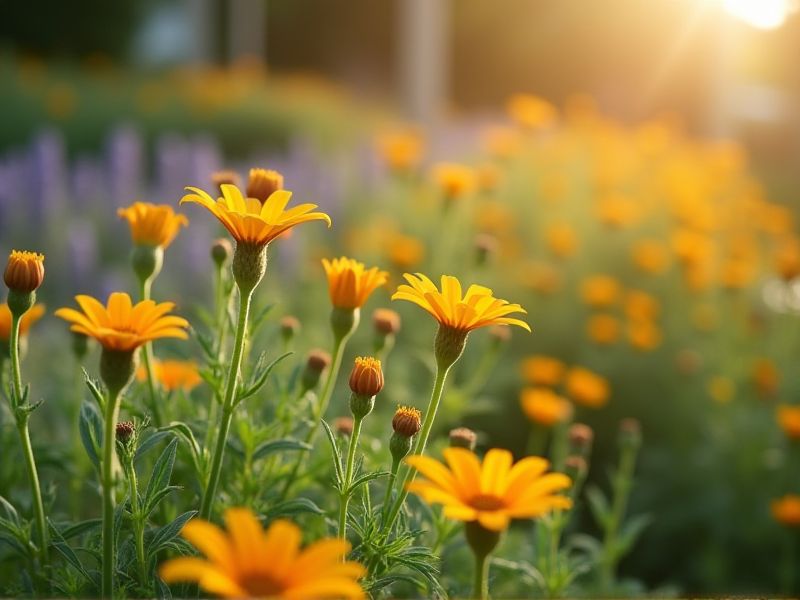
Drought-tolerant plants, such as succulents, native grasses, and certain perennials, are essential for sustainable landscaping in arid regions. Varieties like Agave, Sedum, and Echinacea not only require minimal water but also enhance biodiversity by providing habitats for wildlife. Using these plants can significantly reduce your water consumption while maintaining vibrant garden aesthetics. Native plants, which have adapted to local climate conditions, offer resilience against drought and promote soil health. Incorporating these species into your garden not only supports ecological balance but also ensures long-term viability in changing climate conditions.
List of some Drought-tolerant plants that thrive
- Agave (Agave americana)
- Lantana (Lantana camara)
- Lavender (Lavandula angustifolia)
- Yarrow (Achillea millefolium)
- Russian Sage (Perovskia atriplicifolia)
- Feather Grass (Stipa tenuissima)
- Sedum (Sedum spp.)
- Sagebrush (Artemisia tridentata)
- Rosemary (Rosmarinus officinalis)
- Bougainvillea (Bougainvillea spp.)
Important things about Drought-tolerant plants that thrive
Water-Efficient Adaptations
Drought-tolerant plants, such as succulents and native grasses, exemplify water-efficient adaptations in arid environments. These plants have developed specialized features, such as deep root systems and thick, waxy leaves, allowing them to conserve moisture during prolonged dry spells. Incorporating species like Agave and Lavender into your garden not only reduces water consumption but also promotes biodiversity by providing habitats for local wildlife. By choosing these resilient plants, you can create a vibrant, sustainable landscape that thrives despite challenging weather conditions.
Deep Root Systems
Drought-tolerant plants, such as agaves and succulents, possess deep root systems that enable them to access moisture buried beneath the surface layer of soil. These root systems not only stabilize the plants during dry spells but also enhance their resilience against extreme weather conditions. By tapping into groundwater, drought-tolerant species effectively utilize available water resources, allowing them to thrive in arid environments where traditional crops may fail. Incorporating such plants in your landscape can reduce water usage and promote sustainable gardening practices.
Drought Resistance Mechanisms
Drought-tolerant plants exhibit various strategies to thrive in arid conditions, showcasing remarkable adaptability crucial for survival. These mechanisms include deep root systems that access underground moisture and specialized leaf structures that minimize water loss through transpiration. Some species employ thickened cuticles or waxy coatings, providing an additional layer of protection against dehydration. By selecting drought-resistant varieties like succulents or native grasses, you can cultivate a resilient garden that conserves water and supports sustainable ecosystems.
Soil Moisture Retention
Drought-tolerant plants, such as succulents and native grasses, possess specialized adaptations that enhance soil moisture retention, crucial in arid environments. These plants often feature thick, fleshy leaves or stems that store water, while deep root systems penetrate the soil to access moisture reserves. Mulching around these plants can further improve soil moisture levels by reducing evaporation and regulating temperature, creating a more supportive environment for growth. Choosing drought-tolerant varieties for your garden not only conserves water but also contributes to a sustainable ecosystem by minimizing resource dependency.
Native Species Benefits
Drought-tolerant plants, such as succulents, native grasses, and xerophyte shrubs, showcase remarkable adaptations that allow them to thrive in arid conditions. These plants possess specialized traits, such as deep root systems and fleshy leaves, which enable them to store and conserve water efficiently. By incorporating drought-resistant native species into your landscape, you not only create a sustainable ecosystem but also provide habitat for local wildlife, contributing to biodiversity. Embracing these resilient plants can significantly reduce water usage, making them an ideal choice for environmentally-conscious gardening and landscaping.
Xeriscaping Principles
Drought-tolerant plants, essential to xeriscaping, are expertly adapted to survive in low-water conditions. Varieties such as succulents, native grasses, and flowering perennials, including lavender and agastache, not only conserve water but also enhance your landscape's visual appeal. These plants have developed specialized features like deep root systems and waxy leaves to minimize evaporation and stress during dry periods. By incorporating drought-resistant species, you can create a sustainable garden that thrives even in arid climates while reducing your water consumption.
Seasonal Growth Patterns
Drought-tolerant plants exhibit remarkable seasonal growth patterns, particularly in arid climates where water availability fluctuates. Species such as succulents, agaves, and native grasses are adapted to conserve moisture, thriving during dry spells while entering dormancy during extreme drought conditions. These plants often feature deep root systems, water-storing tissues, and waxy leaves that reduce transpiration, allowing them to survive in less favorable environments. By incorporating drought-resistant landscaping options, you can create a vibrant, low-maintenance garden that flourishes despite limited water resources.
Low Maintenance Requirements
Drought-tolerant plants are ideal for low maintenance gardens, as they require minimal water once established and can endure arid conditions. Species like succulents, lavender, and native grasses not only conserve water but also enhance biodiversity by attracting pollinators. Incorporating these plants into your landscape reduces the need for frequent irrigation, allowing you to save time and resources. Selecting a variety of drought-tolerant flowers and shrubs can create an aesthetically pleasing garden that flourishes even in dry environments.
Heat Tolerance
Drought-tolerant plants, such as succulents, agaves, and certain native grasses, exhibit remarkable heat tolerance, enabling them to survive in arid conditions. These plants possess specialized adaptations, including thickened leaves that store water and extensive root systems that reach deep into the soil for moisture. Species like lavender and rosemary not only withstand high temperatures but also contribute to biodiversity, supporting local ecosystems in challenging climates. By incorporating these resilient plants into your garden, you can create a sustainable landscape that thrives even under extreme heat.
Biodiversity Enhancement
Drought-tolerant plants play a crucial role in enhancing biodiversity, particularly in arid and semi-arid regions. These hardy species, such as succulents and xerophytes, are adapted to conserve water and endure prolonged dry spells, thereby supporting ecosystems under stress. By incorporating native drought-resistant plants into your landscape design, you can create habitats that promote wildlife, including pollinators and beneficial insects. Embracing these resilient plants not only minimizes water usage but also contributes to the overall ecological balance and health of your environment.
